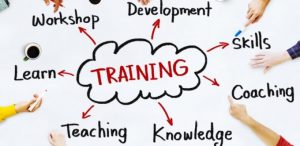
As we settle into the start of the term, it is great to see people on campus, observe the bustle and scramble between classes, and listen to the conversations of students studying hard! There is an excitement and energy unmatched at the beginning of a semester!
As I observe, I start to pick up threads of some common conversations: “What do I have to do for this assignment? Where do I go? Is it on the quiz?” Many of these questions could be answered if communicate clearly, listen, and use some tools to aid our efforts. Clear communications are built into most parts of successful teaching and learning and start from a clear statement of learning objectives to a well-written syllabus, to good directions for homework. We strive to provide lectures and content that insightful and informative to help our students to succeed. This week I want to share two tips related to communication: reinforcing active listening and using technology. I will provide information on two supported technology tools that communication: Webex Teams (formerly Spark) and blogging. Finally, I will invite you to attend an upcoming workshop on September 20 entitled “Efficient and Effective Communication Strategies” co-sponsored by the LEARN Center and the LTC.
Reinforce active listening
What challenges are our students facing? Active listening can help us to understand those challenges so we can provide guidance. Active listening is a valuable skill that asks a listener to make a conscious effort to understand what people are really saying. It requires a listener concentrate, understand, respond, and remember what is said. Active listening helps foster relationships built on trust, respect, and honesty.
The Center for Creative Leadership’s Michael Hoppe identified six steps that enhance active listening.
- Pay Attention – Allow time for the other person to think and speak.
- Withhold Judgment – be open to new ideas, new perspectives, and new possibilities.
- Reflect – Paraphrase key point to get on the same page.
- Clarify – Use open-ended and clarifying questions to draw people into the conversation.
- Summarize – Confirm a sense of mutual understanding.
- Share – After understanding the others perspective, you can incorporate your own ideas, feelings, and suggestions.
Active listening can be used in the classroom as a method to gauge students understanding of the subject, what they think they need to do for an assignment, and whether or not they believe something is on a quiz! Taking the time to listen helps us to craft better communications that meets students’ needs.
Use technology
My second tip this week is to use technology to engage our students and colleagues in (hopefully) active listening. I want to highlight two technologies that the University of Wisconsin Whitewater supports: Webex Teams and Blogging.
Webex Teams
Webex Teams is specifically a communication tool. It is an application that facilitates collaboration. Webex Teams supports group messaging, video meetings, file sharing and white boarding. Webex Teams supports group messaging and creates a secured environment for communications. Messages can be read and responded to right away, or flagged for follow up later. Andrew Cole facilitates a three part bootcamp this fall in McGraw 19A on Wednesday afternoons in October (10/10, 10/17, 10/24) from 3:00 pm to 3:45 pm. The first session on October 10 introduces Cisco Webex Teams and explains why instructors and students might benefit from incorporating it. It is encouraged, but not required, to attend all three sessions.
Blogging
The second tool I want to explore this week is one that I have personally started to use as part of writing TED Tips: blogging. Whitewater supports WordPress and has blogs available for instructional, departmental, student organizations or clubs, and personal use. Setting up your own blog site for classroom use, could be a good way to encourage communications. Share class updates on a blog. By sharing the link to your blog, students and parents can sign up for the update notifications and stay informed throughout the year. You can also create assignments or activities that support your learning objectives by having students create and post blog posts and submit the link to you. More information can be found in the Resources section at the end of this post.
Upcoming Workshop on Communications
Finally, I want to invite folks to attend the first of the LEARN Center/LTC Workshop Series of the year. The theme of the 2018-2019 year is “Back to Basics to Balance Workload”. The first workshop is this coming Thursday, September 20 from 12:30 to 1:45pm in the UC 259A. Lunch is provided! Heather Pelzel from Biological Science and the LEARN Center will be presenting with me.
The theme for the workshop is “Efficient and Effective Communication Strategies.” Strategies to communicate with students while also making good use of your available time will be provided. Good interactions start with setting expectations. Setting boundaries for appropriate times, methods, and places for communications is important; we’ll share some examples. We will discuss considerations and options to do this in the syllabus, as well as in the classroom or online learning spaces. Specifically, we will look at how to identify early indications that your students are struggling and then determine if, when, and how to intervene can play a large role in student retention and success.
Resources:
Back to Basics to Balance Workload Learn Center/LTC Workshop series
Thursday, September 20: “Efficient and Effective Communication Strategies”
12:30-1:45 p.m., Lunch Included
University Center, Room 259A
Register by September 14. If you have any questions about this workshop or for late registrations, please contact Sally Lange at learn@uww.edu or 262-472-5242
Upcoming Back to Basics to Balance Workload Sessions:
October 18: Best Practices on Providing Effective Feedback Using Low-Tech and High-Tech options
November 27: Using Groups to Engage Students and Maximize Your Class Time
Webex Teams Bootcamp
Wednesday, October 10, 2018: Why Should I Use Webex Teams?
Registration Link: http://my.uww.edu/signup/Registration/Details/15660
Webex Teams (Formerly Spark) https://www.uww.edu/icit/services/webex-teams
WordPress Blog Information: https://www.uww.edu/icit/services/blogs

 My first classes were on ground and eventually I transitioned to hybrid and then fully online courses. When the call went out for faculty to help with Canvas, I eventually answered it.
My first classes were on ground and eventually I transitioned to hybrid and then fully online courses. When the call went out for faculty to help with Canvas, I eventually answered it. 





